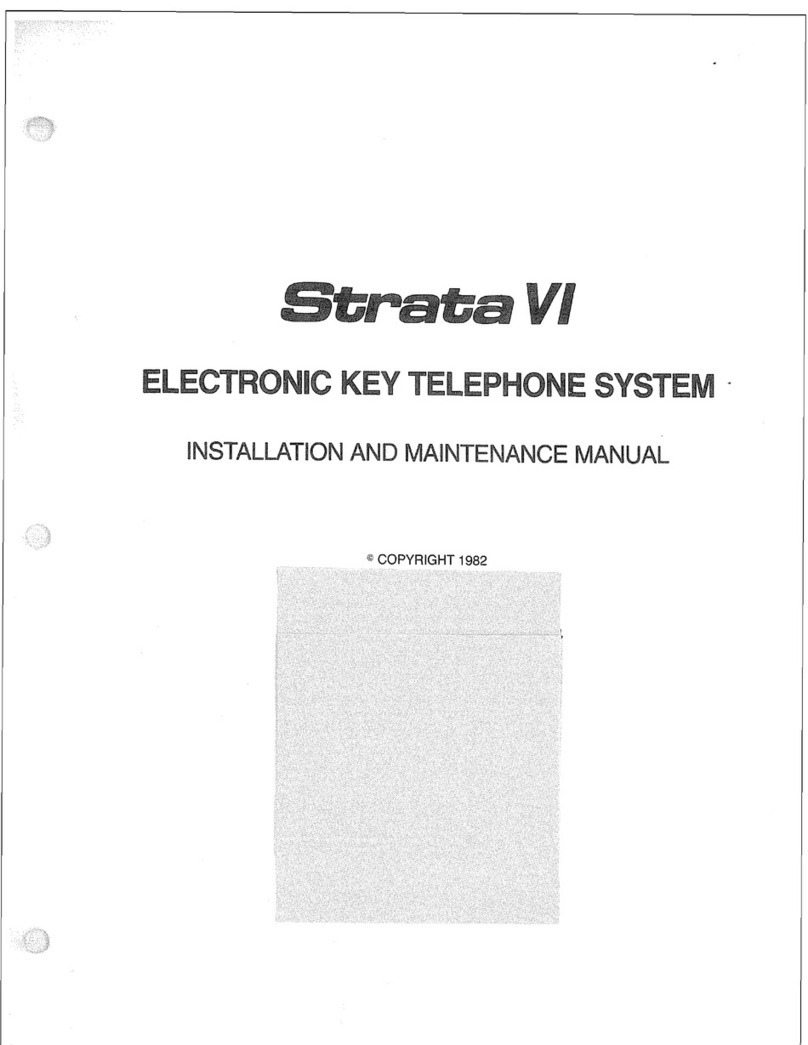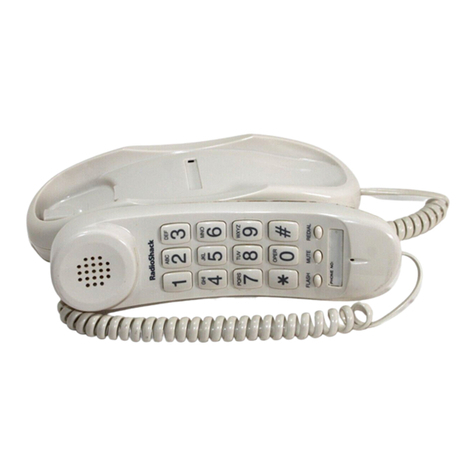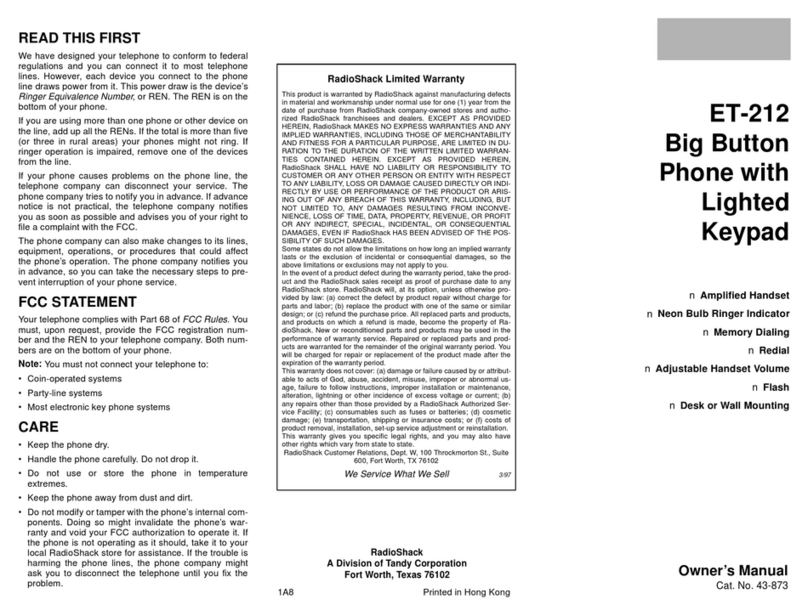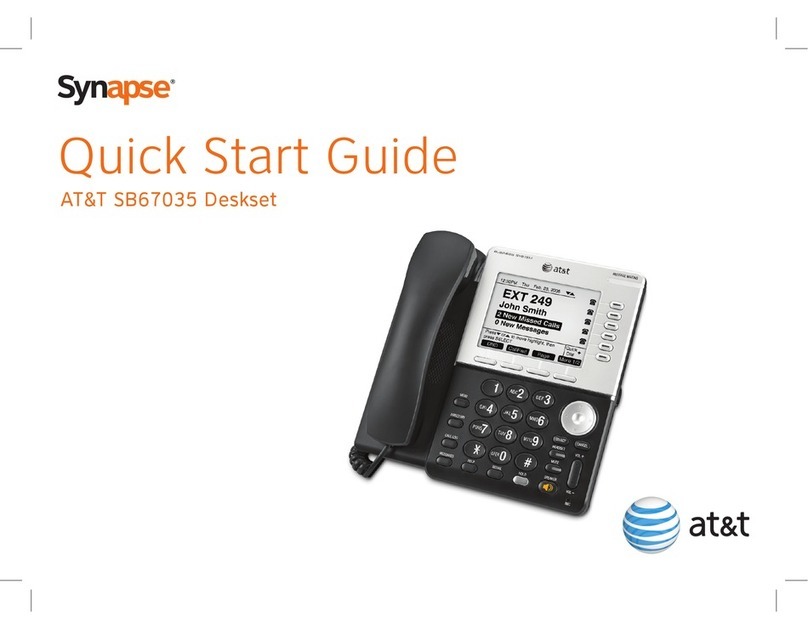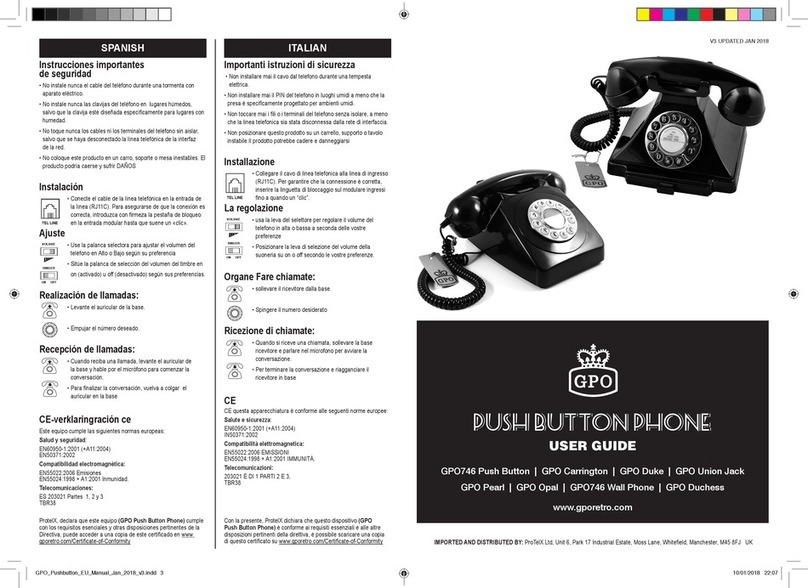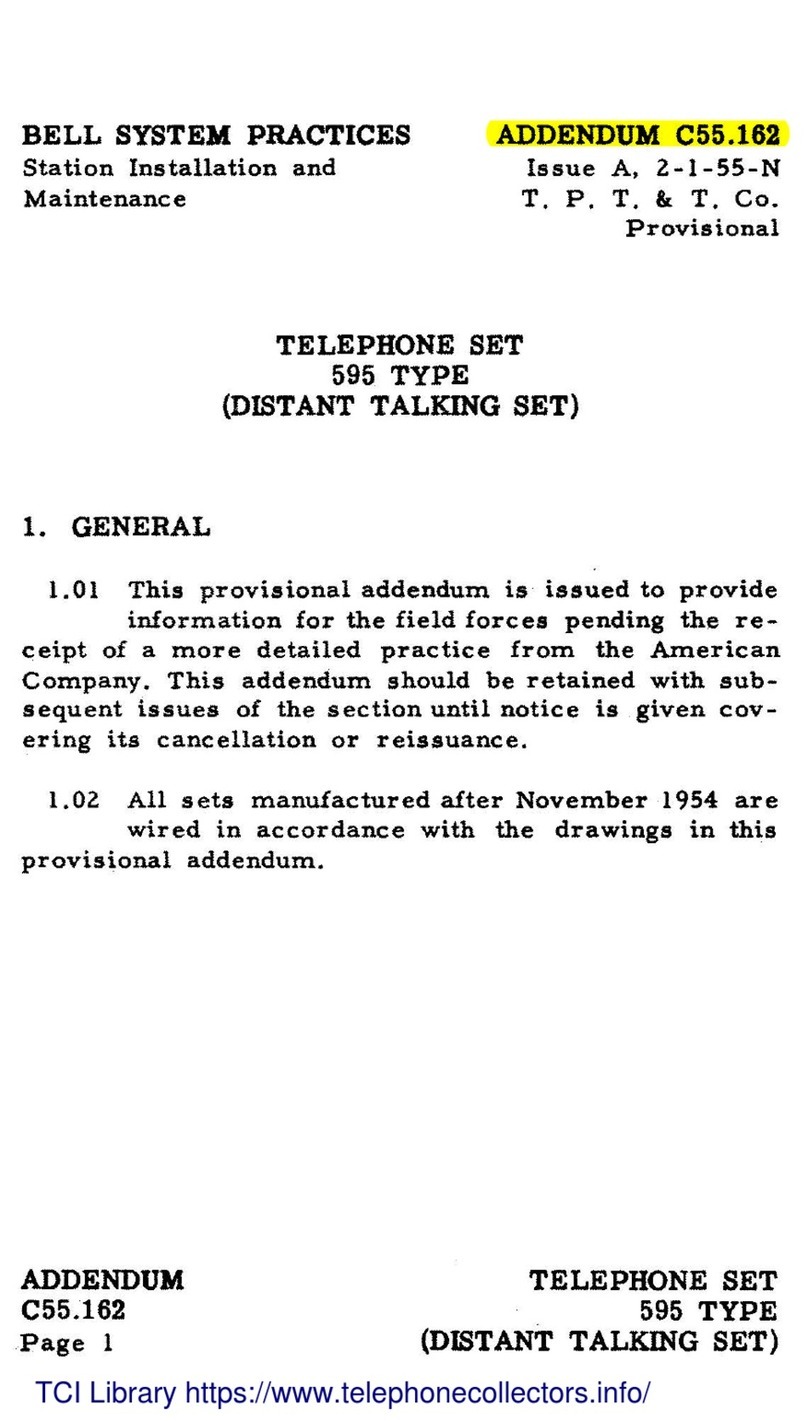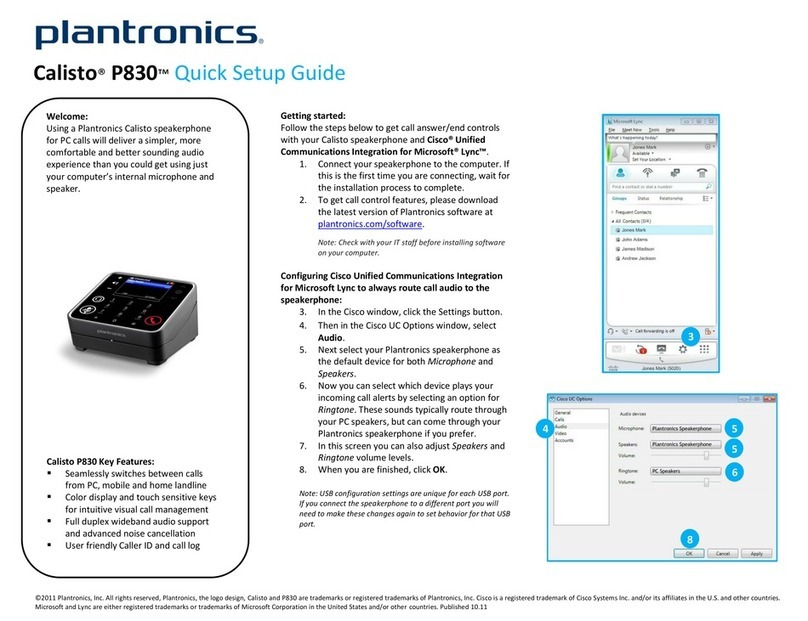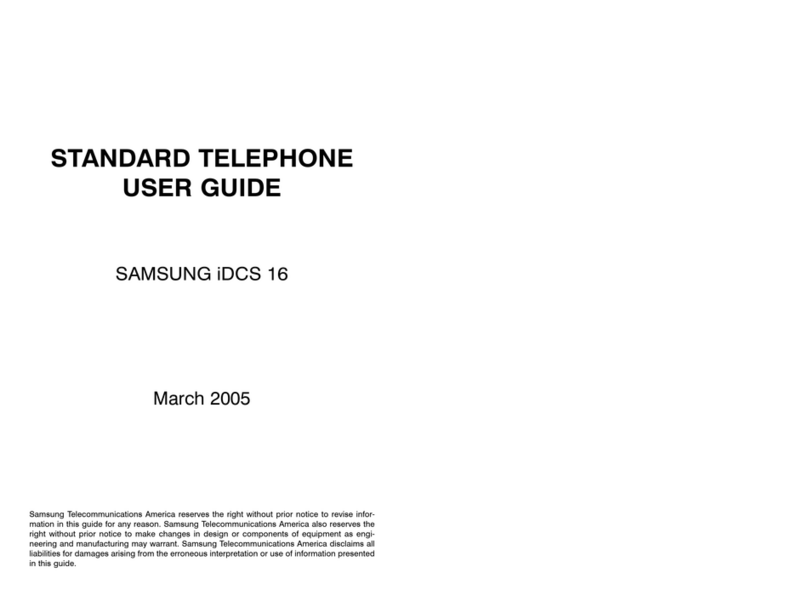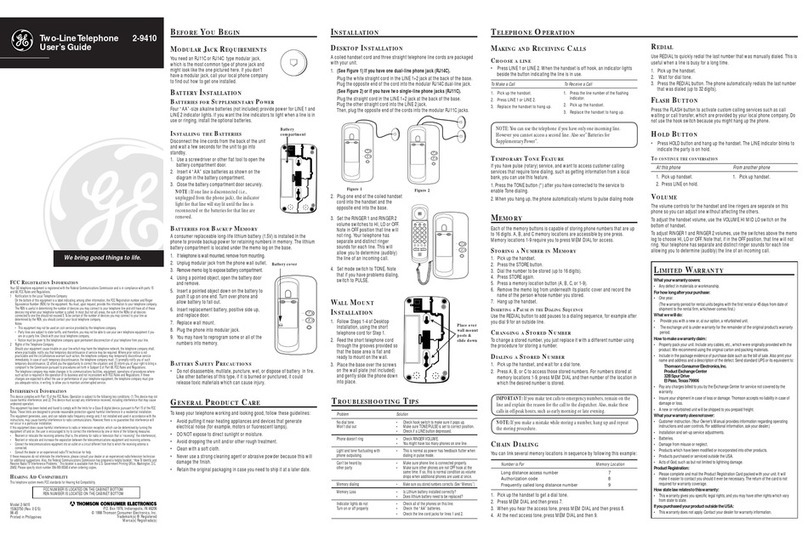GENERAL SYSTEM PRACTICES ENGINEERING-PLANT Series Instruction Manual

GENERAL SYSTEM PRACTICES
ENGINEERING-PLANT SERIES
SECTION 473-301-200
ISSUE 1, JUNE, 1965
GT&E STANDARD
INSTALLATION AND FIELD MAINTENANCE
A. E. CO .
TYPE 183 TELEPHONE
CONTENTS.
PAGE
1.
GENERAL
1
2. INSTALLATION .
2
Dial Assembly and Handset Hook
Positioning
2
Desk-Mounting Instructions
2
Wall-Mounting Instructions
3
Connection Instructions for a Self-
Compensating Type 183
Telephone .
3
Connection Instructions for a
Manually Adjusted Type 183
Telephone .
3
3.
LOOP COMPENSATION
ADJUSTMENT .
4
Party Line and Extension Telephones
4
P-A-B-X, P-B-X, etc.
4
Line Current Adjustment
.
4
Polarity Check
.
5
4.
FIELD MAINTENANCE
5
Hookswitch Wire Shield Removal .
5
Transmitter and Receiver Capsule
Replacement
6
Dial Assembly and Handset Hook
Removal .
6
Dial Replacement
6
Radio Frequency Suppression .
8
1.
GENERAL
1.01
This section provides installation and
field
maintenance procedures for the
Type 183 telephone (Figure 1).
1.02
The Type 183 telephones now being manu-
factured have a self-compensating type
transmission unit. Earlier Type 183 telephones
are equipped with a
manually adjustable
rheostat for loop compensation.
A Type 183
telephone is electrically equivalent to its cor-
responding Type 80 telephone.
1.03
The Type 183 telephone is designed for
mounting on a vertical surface.
The
telephone can be adapted to anyone of a variety
of installation locations by changing the position
Copyright c1965
Automatic Electric Company
1
of 8
Figure 1. Type 183 Telephone.
FRONT COVER
SCREWS
FRONT COVER
DIAL
ASSEMBLY
HANDSET
HOOK
HANDSET
of the dial assembly and/or the handset hook.
The dial assembly can be rotated 360° and
can be secured in any position along that rota-
tion. The handset hook can be moved along a
180° arc around the front of the telephone and
can be secured in any one of seven positions.
1.04
The Type 183 telephone with ABC dial, B
SATT dial, or less dial is available
in black, beige, green, ivory, turquoise, yellow,
pink, and white.
1.05
If a ringer is required, a Type 33 ringer
unit should be installed as outlined in the
related publication in the 473 series.

Desk-Mounting Instructions
2.03
It
will usuallybe preferable to locate the
Type 183 telephone at the left front corner
of the desk.
2.04
The telephone can be attached to the edge
of the top of a wood desk or to a special
bracket (D-731725-A) installed under the desk-
top overhang (Figure 3) by installing No. 8 wood
screws through the cutouts in the baseplate
(cutouts marked "A" in Figure 4).
2.05
To mount a Type 183 telephone on a metal
desk, holes must be drilled to accommo-
date No. 8 machine screws. The holes should be
drilled in the side of the desk in the pattern
shown for holes marked "A" and "B" in
Figure 4. A hole must also be drilled to align
with the oblong-shaped wire hole. If the run of
inside wire is to connect first to the telephone
and from there extended to a ringer, then
another wire hole must be drilled to align with
the circular wire hole (Figure 4). The oblong-
shaped wire hole in the baseplate should always
be the hole used for incoming wire which must
pass through the baseplate. The circular wire
hole should be used only when extending the wire
run.
The Type 183 telephone should be attached
to the desk with four No. 8 machine screws,
lockwashers, and nuts.
2 of 8
Figure 2. Self-Compensating Type 183
Telephone - Cross Section.
2.
INSTALLATION
2.01
The Type 183 telephone may be mounted
on the side of a desk, on a wall, or on
other flat vertical surfaces.
The baseplate
has six cutout holes through which mounting
devices can be installed.
The front cover of
the telephone must be removed to gain access
to the cutouts.
The cover is secured to the
housing by two Phillips-head screws located at
the bottom of the cover. At SATT or divided-
ringing stations, make a polarity check (see
Paragraph 3.12) after wire connections have
been completed.
Dial Assembly and Handset Hook
Positioning
2.02
After the front cover has been removed,
but before the telephone has been
mounted, the dial assembly and handset hook
must be secured in the position required for
that particular installation. The final position
of the dial assembly and handset hook must be
the position most convenient for their use at the
telephone location.
The dial assembly can be
rotated 360° when the Phillips-head lockscrew
beneath the dial assembly ball grip (Figure 2)
is loosened. Tightening the lockscrew secures
SECTION 473-301-200
ISSUE 1
the dial assembly in position. The same lock-
screw is part of the mechanism that holds the
handset hook in position. The handset hook can
be moved through an arc of approximately 180°
when the lockscrew has been loosened suffi-
ciently for the circular die-cast plate (on which
the
hookswitch
is
mounted) to be moved down-
ward about 1/8-inch.
By meshing one of the
slots in the circular plate with the ridge on the
surface over which the edge of the circular plate
passes when rotated, and when tightening the
lockscrew, the handset hook can be secured in
position.
Seven of the slots in the circular plate
will mesh with the ridge.
NOTE:
When positioning the dial assembly
and/or the handset hook, care must
be taken not to damage wires by
careless twisting of the dial as-
sembly or hook, or by rotating the
dial
assembly in one direction
through
more than one full turn. The
lockscrew must be firmly tightened
to
minimize the possibility of wire
damage caused by the customer
rotating either the dial assembly or
the handset hook.
The customer
should be advised that he is not to
reposition
the dial and handset
hook.

SECTION 473-301-200
ISSUE
1
Wall-Mounting Instructions
2.06
The location (including distance above the
floor) of the Type 183 telephone on a wall
must be determined, as far as practicable,
according to the needs of the customer. The
four cutout. holes marked "A" and "B" in
Figure 4 must be used to mount the telephone
on a wall or other flat surface. To mount the
telephone, install one No. 8 screw through
either of the holes marked "A". Install a
second No. 8 screw through the oblong hole
marked "B".
Position the telephone so that it
is exactly vertical and install a No. 8 screw in
each of the other holes marked "A" and "B".
If
masonry anchors are required, use the
dimensions in Figure 4 to establish the location
on the wall at which the anchors will align with
holes "A" and "B", and install the anchors
accordingly.
2.07
Holes marked "C" in Figure 4 are to be
used when the Type 183 telephone is
mounted over an, electrical outlet box.
Connection Instructions for a Self-
Compensating Type 183 Telephone
2.08
A self-compensating Type 183 telephone
has, stamped on the baseplate, a code
Figure 4. Baseplate Diagram.
number prefixed with the letters NB. A
schematic diagram and a wiring diagram of the
self-compensating type circuit are shown in
Figure 9. Station wire must be connected to the
transmission unit terminal strip as follows: red
wire to terminal 15, green wire to terminal 16,
and yellow wire (used for SATT or divided ring-
ing only) to terminal 20. Ringer connections are
described in related publications in the 473
series.
2.09
When the self-compensating Type 183
telephone is equipped with a SATT dial,
the brown dial wire must be connected to trans-
mission unit terminal 20.
Connection Instructions for a Manually
Adjusted Type 183 Telephone
2.10
A manually adjusted Type 183 telephone
has, stamped on the baseplate, a code
number prefixed with the letter L. A schematic
diagram and a wiring diagram of the manually
adjusted
Type 183 telephone are shown in
Figure 10. Station wire must be connected to
the transmission unit terminal strip as follows:
red wire to terminal 15, green wire to terminal
16, and yellow wire to terminal 17. Ringer
connections are described in related publica-
tions in the 473 series.
2.11
When a manually adjusted Type 183 tele-
phone is equipped with a SATT dial, the
white hookswitch wire must be removed from
3 of 8
Figure 3. Special Desk-Top Mounting.

SECTION 473-301-200
ISSUE 1
transmission unit terminal 17 and taped. The
brown dial wire must then be connected to
terminal 17.
3.
LOOP COMPENSATION ADJUSTMENT
3.01
The manually adjusted Type 183 tele-
phone has a rheostat which regulates the
conductor loop resistance. . The front cover
must be removed to gain access to the rheostat.
The rheostat is located at the bottom of the
telephone.
The rheostat setting can be changed
by turning the slotted arrow with a small screw-
driver.
As the arrow is turned counterclock-
wise from 0 to 4, the rheostat inserts 0 to 400
ohms in series with the loop.
3.02
When the rheostat
is at 0, as it should be
for long cable loops, a switch operates to
add a capacitor and a resistor into the sidetone
balancing impedance, to match more nearly the
capacitive impedance of a long cable loop.
3.03
On lines in a 48- or 50-volt exchange,
except as specified in (a) and (b) below,
set the rheostat at 2 if conductor loop resis-
tance is 200 ohms or less, but if the conductor
loop resistance is over 200 ohms, set the
rheostat at 0.
(
a)
If the station is connected directly
to
an open wire section over 200
ohms resistance, set the rheostat
midway between 0 and 1.
(
b)
If the station is on a loaded customer
loop and is less than one loading
section (for Type H loading, less than
6000 feet) from the nearest loading
coil,
set
the rheostat
midway
between 0 and 1.
Party Line and Extension Telephones
3.04 If two or more A.E.Co. telephones with
manually adjusted loop compensation
(
Type 80, Type 90, etc.) are used on one line
with a Type 183 telephone, set the rheostat of
each as if it were the only telephone on the line.
If the Type 183 telephone is used on the same
line with an entirely different
make or model
of telephone, set the Type 183 rheostat at
0;
or,
if one of the exceptions described in Paragraph
3.03(a) or 3.03(b) is applicable, set the rheostat
midway between 0 and 1.
P-A-B-X, P-B-X, etc.
3.05 In a key system, P-B-X, or P-A-B-X,
a
Type 183 telephone may receive its
transmitter current from either of two dif-
ferent 48- or 50-volt sources.
Adjust the
4 of 8
rheostat for the current received on a trunk
(outside) call as described in (a) through (c)
below, except where the telephone is part of a
P-B-X system
which
has a switchboard
equipped with non-relay series lamp-line cir-
cuits, in which case the telephone set rheostat
must be set at 0 (see Paragraph 3.06).
(
a)
If the station loop plus trunk resist-
ance is 200 ohms or less, set the
rheostat at 2.
(b)
If the station loop plus trunk resist-
ance is over 200 ohms, set the
rheostat at 0.
(c)
If
long-line equipment or a pulse
repeater at the P-B-X or P-A-B-X
supplies
transmitter
current on
trunk calls, set the rheostat at 2.
3.06 If the central office or a P-B-X switch-
board operates from 24 volts and has
100 ohms plus 100 ohms battery feed coils, or
uses non-relay series lamp-line circuits, set
the rheostat at 0; otherwise set the rheostat as
described in Paragraph 3.05.
Line Current Adjustment
3.07
The adjustment procedures described in
the preceding paragraphs of Part 3 are
adequate for most installations.
However, a
few installations will require accurate line
current adjustment to 60 milliamperes. This
more accurate adjustment might be required
where there has been a transmission complaint,
or where it is suspected that the reason for a
customer's difficulty in hearing over the tele-
phone is caused by room noise at the telephone
location. If sidetone caused by room noise is the
problem, it might be desirable to adjust to a line
current of 55 or 50 milliamperes. Adjustment
can be made by following one of the methods
described in Paragraphs 3.08 through 3.11.
3.08
The loop compensation adjustment can be
made without central-office assistance by
proceeding as follows:
(1)
Remove the front cover of the tele-
phone and disconnect the red wire at
transmission unit terminal 15.
(2)
Connect a milliammeter between
the
red lead and terminal 15 so that the
milliammeter is in series with the
line (Figure 5).
(3)
Take the handset off the
hook and
vary the loop compensator until the
milliammeter
reads
60 milliam-
peres.

SECTION 473-301-200
ISSUE 1
Polarity Check
3.12
On manually adjusted and self-compen-
sating telephones used in SATT instal-
lations it is important to check that the party
identity pulse is on the positive line.
The
polarity can be checked at either the ringeror
at the telephone transmission unit terminals.
An Automatic Electric Company Type 800
handtest telephone can be used to make this
test.
Place the handtest telephone C/R switch
to the "C " position and clip one test lead to the
ground terminal.
Listen for a click as you
touch the other lead to each line wire. The
louder click, sometimes followed by dial tone,
indicates
the -line (ring).
The + line (tip)
usually will not sound completely dead, but will
give a weaker click due to earth potential
difference.
3.13
At divided-ringing party-line stations,
clip one lead of an A.E.Co. handtest
telephone to the ground wire. With the other
clip, touch each line wire and listen for a click.
The louder click indicates the negative line
(
ring).
Figure 5.
Milliammeter Connection.
(4)
Disconnect the milliammeter, re-
connect the red wire to terminal 15,
replace the housing, and test trans-
mission.
3.09
When the testboard is equipped for line
current measurement through the usual
200 ohms plus 200 ohms battery feed, dial the
testboard and request line current measure-
ments. The testboard attendant will announce
current
measurement readings.
Vary the
rheostat until the current is 60 milliamperes.
3.10
When the testboard is equipped for line
resistance measurement, dial the test-
board and request line resistance measure-
ments.
Short-circuit the line while the test-
board attendant measures loop resistance.
Using the measurement furnished by the test-
board attendant, set the loop compensator
according to Figure 6.
3.11
When the testboard is equipped for line
voltage measurement, dial the testboard
and request a line voltage measurement and
stay on the line.
The testboard will be con-
nected to the calling line through a test distrib-
utor or distributing frame test shoe, and a
voltmeter will be connected across the line.
The adjustment procedures for the two most
usual exchange situations encountered are:
(a)
Where battery is fed through 200
ohms plus 200 ohms, which is usual
in 48- or 50- volt exchanges, vary
the loop compensator until the test-
board voltmeter reads 24 volts less
than the central-office
battery
voltage.
(
b)
Where battery is fed through 100
ohms plus 100 ohms, which is used
in
many 24-volt exchanges, vary the
loop compensator until the testboard
voltmeter reads 12 volts less than
the central-office battery voltage.
5 of 8
4.
FIELD MAINTENANCE
4.01
Procedures for removing and replacing
the dial fingerwheel are provided in the
related publication in the 473 series. Schematic
diagrams of transmission units are shown in
Figure 7. The schematic diagrams can be used
for continuity tests or resistance measure-
ments.
The sealed transmission unit is not
to be repaired in the field.
If the unit mal-
functions, replace it with a new one.
Hookswitch Wire Shield Removal
4.02
To protect the wires and springs of the
movable hookswitch, a clear-plastic wire
shield is provided (Figure 8). This shield
assures that the wires and springs will not
become tangled when the installer changes the
hook
position.
Refer to Figure 8 and use the
following steps to remove the wire shield.
Figure 6. Line/Conductor Loop Resistance.
LINE/ CONDUCTOR LOOP RESISTANCE
(NOT INCLUDING TELEPHONE INSTRUMENT OR CENTRAL OFFICE RELAYS)

Figure 8. Hookswitch Wire Shield Removal.
6 of 8
4.04
Manually adjusted Type
183
telephones
are equipped with Type 81 handsets only.
The transmitter and receiver capsules of the
Type 81 handset are not interchangeable with
capsules from other handsets. For. replace-
ment of capsules, and/or handset refer to the
related publication in
473
series.
Dial Assembly and Handset Hook Removal
4.05
The dial and handset hook should be re-
moved as follows (replacement can be
accomplished by reversing the procedure):
(1)
Remove the front cover and dis-
connect all dial and hookswitch wires
from the transmission unit terminal
strip (Figure 9 or 10).
(2)
Loosen the Phillips-head lockscrew
(
Figure
2)
sufficiently for the cir-
cular die-cast plate (on which the
hookswitch is mounted) to be moved
downward approximately 1/8-inch.
(3)
Turn the assembly to the left (facing
the telephone set) until the handset
hook is at a position where further
turning is not possible. The circular
plate will now be in a position where
all
of its slots mesh with similar
size projections along the edge of the
rigid die-cast structure.
t4)
Carefully withdraw the dial assem-
bly and handset hook from the tele-
phone housing.
Dial Replacement
4.06
The dial can be replaced by performing
the procedure following on page
8.
Figure 7. Transmission Units - Schematic Diagrams.
7a.
Transmission Unit Circuit Used in a
Self-Compensating Type 183 Telephone.
7b.
Transmission Unit Circuit Used in a
Manually Adjusted Type 183 Telephone.
SECTION
473-301-200
ISSUE 1
(1)
Move the top of the wire shield away
from the bracket (Figure
8)
to
release the shield studs from the
shield slots in the bracket.
(2)
Slide the wire shield up until it is
clear of the retaining spring.
(3)
Position the wire shield as shown
in Figure 8 and apply pressure
simultaneously in directions de
noted by arrows A and B. Slide
the wire shield out from under the
buffer.
Transmitter and Receiver Capsule
Replacement
4
.03 Self-compensating Type 183 telephones
are equipped with Type
810
handsets only.
The transmitter and receiver capsules of the
Type 810 handset are not interchangeable with
capsules from other handsets. For replace-
ment of capsules and/or handset, refer to
related publication in the
473
series.

Figure 9. Schematic and Wiring Diagram for the Self-Compensating Type 183 Telephone.
H-54518, ISS. 6
NOTE:
CONTACTS TO SPEAK LAST 0
MADE FIRST
SECTION 473-301-200
ISSUE 1
H-54476, ISS.7
Figure 10. Schematic and Wiring Diagram for the Manually Adjusted Type 183 Telephone.
7 of 8

(1)
Remove the three dial-mounting
screws located at the rear of the
dial housing assembly.
(2)
Lift the dial assembly and mounting
bracket from the dial housing.
(3)
Remove the three mounting bracket
screws and remove the bracket.
(4)
Loosen the terminal screws on the
dial spring assembly and remove the
dial wires.
NOTE: The dial wires should not be
removed from the trans-
mission unit unless the
wires are damaged.
(5)
Connect the dial wires to the new dial
(
Figures 9 or 10).
(6)
Fasten the dial mounting bracket
(removed from the old dial) to the
new dial.
(7)
Insert the dial and mountingbracket
into the dial housing. Position the
last finger hole (the one nearest the
finger stop) so that it is exactly at
the
bottom of the dial housing.
(8)
Insert
the
three
dial
mounting
screws through the rear of the dial,
housing and tighten to the dial
housing.
4.07 If the dial is replaced by a dial blank,
disconnect the dial wires at the dial
assembly and:
SECTION 473-301-200
ISSUE 1
(1)
Connect the YEL and BLU dial wires
to dial blank terminal 2.
(2)
Connect the RED dial wire to dial
blank terminal 1.
(3)
Connect the WHT dial wire to dial
blank terminal 3.
(4)
Fasten the dial blank to dial cup.
Radio Frequency Suppression
4.08
Effective suppression of radio signals
can be obtained by connecting
three
0.03 mfd ceramic capacitors in telephones with
a self-compensating network and one 0.03 mfd
capacitor in telephones that are manually
adjusted.
4.09
At the transmission unit of self-compen-
sating telephones (Figure 9), connect the
capacitors between terminals: 2 and 4, 3 and 5,
and 5 and 1.
4.10
For
manually
adjusted
telephones
(
Figure 10), connect a 0.03 mfd capac-
itor across terminals 6 and 9; or, across the
transmitter terminals in the handset, which-
ever is more convenient.
4.11
A suitable capacitor is D-68782-AU
ceramic 0.03 mfd (+/-20%)
500
WV. The
leads should be insulated to within one-half
inch of the ends with 0.042 inch I.D. sleeving,
D-542410-A.
8 of 8
This manual suits for next models
1
Table of contents
